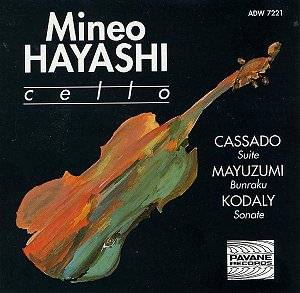|
|
Search MusicWeb Here |
|
 |
||
|
Founder:
Len Mullenger (1942-2025) Editor
in Chief:John Quinn
|
|
|
Search MusicWeb Here |
|
 |
||
|
Founder:
Len Mullenger (1942-2025) Editor
in Chief:John Quinn
|
 |
Gaspar CASSADO (1897-1966)
Suite for Cello Toshiro MAYUZUMI (b.1929) Bunkaru for Cello Zoltan KODALY (1882-1967) Suite for Cello op 8 Recorded Studio 1, RTBF-Flagey, Brussels April 1990 |
| CD available for post-free online mail-order or you may download individual tracks. For some labels you can download the entire CD with a single click and make HUGE savings. The price you see is the price you pay! The full booklet notes are available on-line. | |
|
NOTE • Click on the button and you can buy the disc or read the booklet details • You can also access each track which you may then sample or down load. • Further Information. |
|
|
Mineo Hayashi, Tokyo-born, studied with Casals’ first Japanese pupil, Yoshio Sato. A soloist and chamber musician he now plays in the distinguished Saito Kinen orchestra and has constructed an estimable recital of solo cello works, cannily ordered, of real musical worth. He has had the acumen to begin with the Cassado Suite and end with the far greater challenges – technical and expressive – of the Kodaly; in between comes a work by a contemporary Japanese composer, Toshiro Mayuzumi.
Cassado, one of the outstanding cellists of his day, composed a significant number of works, some for his own instrument, including a concerto, but also a piano trio and the Rhapsodia Catalan. The solo Suite is a more than welcome addition to the repertoire. It is a most attractive work with a Preludio-Fantasia first movement that is distinctly Spanish in texture and melodic impress. Hayashi’s lean tone is employed in accommodating Cassado’s very high lying writing and with the several moments of extrovert and flourishing rhetorical profile. In the dancing second movement – a Sardana – there is a voracious and animated vocal core. Hayashi is alive to the flickering momentum here but his range of tone colours is relatively limited and not fully at the service of Cassado’s imaginative writing whereas he is admirably successful in the Intermezzo e Danza finale where we find Cassado effortlessly and successfully embedding dance idioms into the fabric of the score.
Mayuzumi’s Bunkaru (1960) is an attempt to conjure and evoke the Samisen, a Japanese three-stringed plucked instrument and to fuse its sonorities and impulses to western cello technique. The result opens with pizzicatos underpinning a melodic line of suggestible interest. Notes are bent, an Eastern aesthetic evoked and the Cello seems thus to undergo, in the eight minute span of the work, a kind of transformative and illusory movement.
Kodaly’s masterpiece has never lacked for advocates. Beatrice Harrison was an early proponent, though she never recorded it, but it was Janos Starker who most indelibly stamped his leonine personality on the work. Hayashi is consistently slower than the Hungarian cellist, a considerable matter of three minutes slower in the second movement and nearly two in the third and final movement. Starker is electrifying in this work, binding the rhetoric with superb technical address and minuscule gradations of tonal inflection and adduced meanings, Hayashi’s more considered recording is somewhat more discursive – in the opening allegro one never quite feels the architectural grip that Starker engages. Listen to the opening phrases of the adagio and hear the range of dynamics and tonal shading Starker employs; by comparison Hayashi, never insensitive, is nevertheless relatively monochrome and predictable in his response. Starker’s bowing is memorable here and he builds to the peak of a phrase with inexorable conviction. Hayashi can’t match the older playing in tonal flexibility or in delineating the rise and fall of the music – a considerable matter in a work of this kind. But as I noted this is a good, thoughtful programme and it is persuasively, if not always optimally, played. Pavane’s imagination – and that of their soloist – is strongly to be commended. Jonathan Woolf
|
| ADDITIONAL INFORMATION •
You can sample only 30 seconds (or 15% if that is longer) of a given track. Select from the View tracks list. Each sample will normally start from the beginning but you can drag the slider to any position before pressing play. • PLEASE NOTE: If you are behind a firewall and the sound is prematurely terminated you may need to register Ludwig as a trusted source with your firewall software.
•You will need Quicktime to hear sound samples. Get a free Quicktime download here • If you cannot see the "Sample All Tracks" button you need to download Flash from here.
|
|
|
Return to Index |